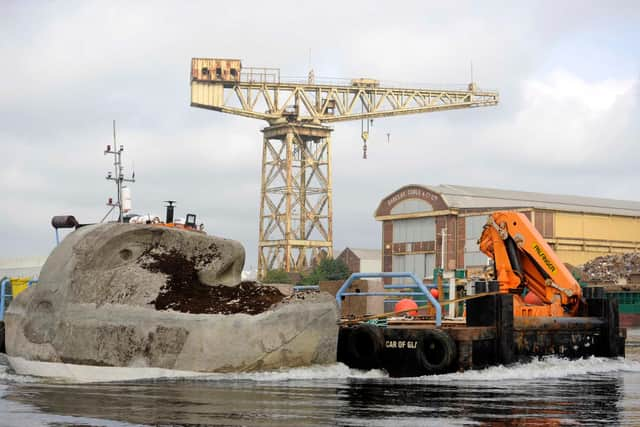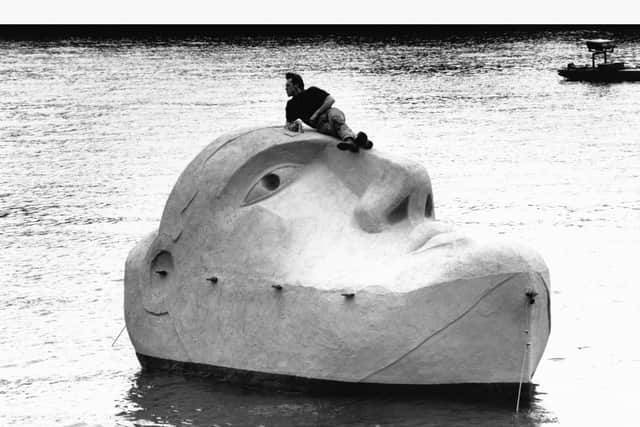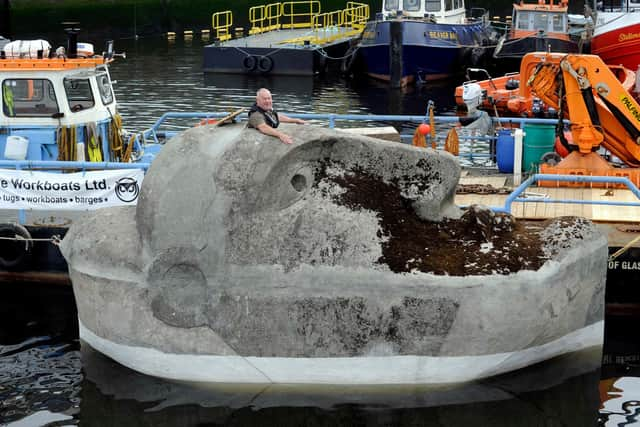Family welcomes Floating Head back to the Clyde after more than three decades
Richard Groom created the 27-tonne concrete and steel structure for the Glasgow Garden Festival in 1988.
After the mega event was dismantled, the head was put into storage, saved from demolition, rescued and then moved to Rothesay Dock East on the north of the river, where it lay largely forgotten.
Advertisement
Hide AdAdvertisement
Hide AdMr Groom died in 2019 with his brother heading on a determined mission to find the head, which the city gave the nickname Bob, after recollections of the artist’s work were shared at his funeral.


At the weekend, Mr Groom’s mother Audrey cut the ribbon at the official event to mark the return of the head, which is now floating at Canting Basin near Glasgow Science Centre.
Kate V Robertson, co-director of the Sculpture Placement Group, which led the project to get the head back on the water, said: “It was a really special day. Richard’s mum cut the ribbon and said ‘welcome back Bob’.
" We are really happy that we were able to give the family a day to celebrate.
"It was also special for everyone involved in getting the Floating Head back on the water. We have worked so hard, and so long, to get it there.”


Mr Groom made the sculpture for the garden festival with the help of out-of-work shipbuilders.
The seven-metre long sculpture, with its stoic, expressionless appearance and enormous size, has been compared to an archaeological relic of an ancient lost civilisation.
After the festival, the head was stored on land that later became a scrapyard, with the creation then moved to Rothesay Dock East at Clydebank.


Advertisement
Hide AdAdvertisement
Hide AdMr Groom’s brother Andy located the head after scouring satellite images of the dockyards that line the Clyde.
It was then conserved and partially restored by workers from Concrete Repairs Ltd, in a project led by the Sculpture Placement Group and Mr Groom’s estate.
The sculpture will be moored in the Canting Basin as part of Glasgow Doors Open Day, until October 6 when it will be moved back into storage as the COP26 climate change conference gets underway.
It is hoped that a new permanent home will be found for Bob – either on water or on land.
Ms Robertson said: “We know from our research that there is a real demand for outdoor sculpture.
"People recognise the impact works like Angel of the North can have. These things can really become iconic landmarks and we really feel that the Floating Head has great potential.”
The project has been supported by the Construction Industry Training Board, Glasgow City Heritage Trust, Sustrans Scotland’s ArtRoots fund, National Lottery Community Fund and through a crowdfunder.
A spokeswoman for Glasgow City Heritage Trust said: “The Garden Festival of 1988 holds a special place in the memories of many Glasgwegians and marked a turning point in Glasgow’s transformation from industrial powerhouse to cultural centre.
Advertisement
Hide AdAdvertisement
Hide Ad"The refloating of Richard Groom’s sculpture and the programme of activities with Glasgow Science Centre offers an exciting opportunity to engage Glasgow’s communities with the legacy of the Garden Festival and Glasgow’s shipbuilding heritage.”
A message from the Editor:Thank you for reading this article. We're more reliant on your support than ever as the shift in consumer habits brought about by Coronavirus impacts our advertisers.
If you haven't already, please consider supporting our trusted, fact-checked journalism by taking out a digital subscription.
Comments
Want to join the conversation? Please or to comment on this article.
